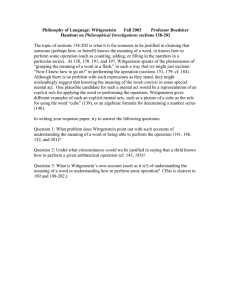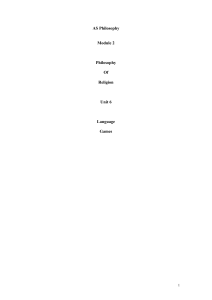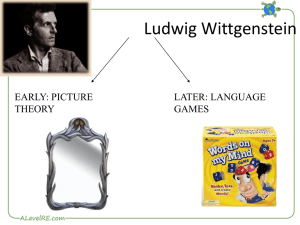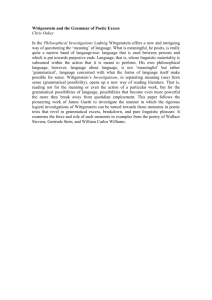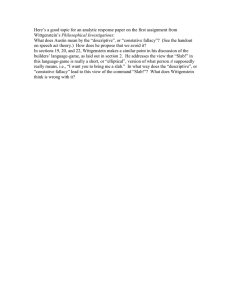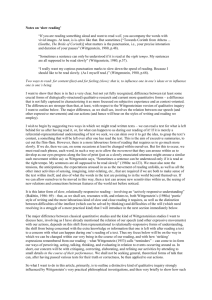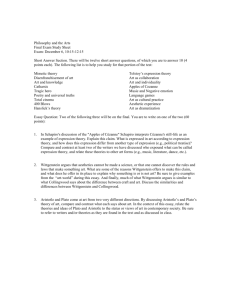Wichita State University Libraries SOAR: Shocker Open Access Repository
advertisement
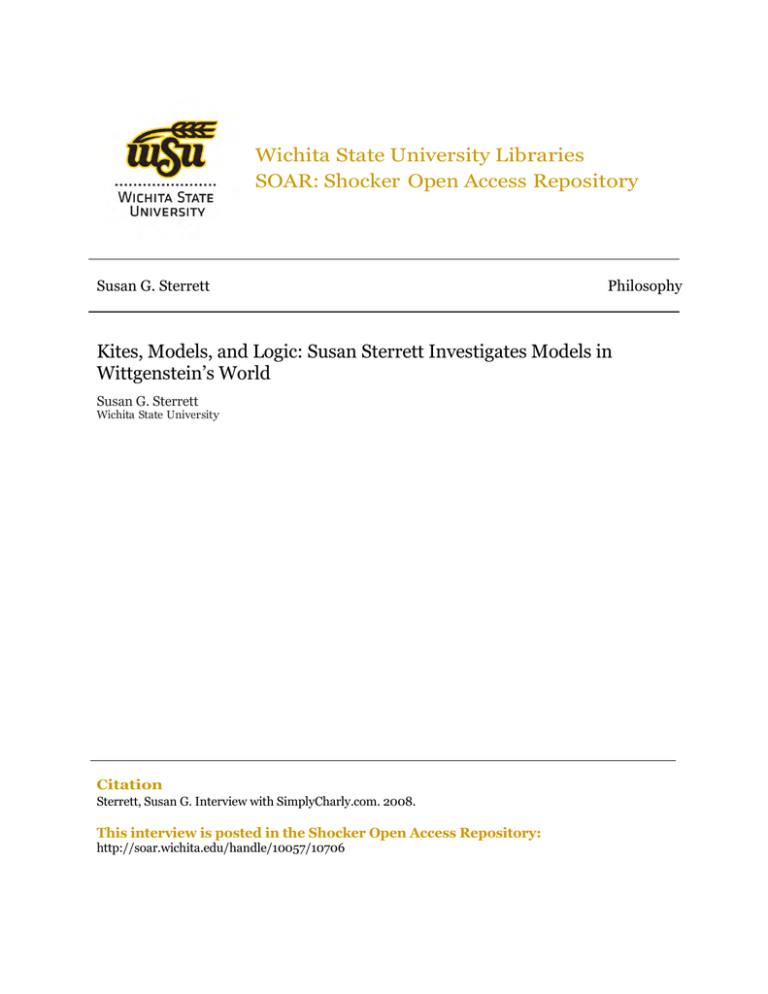
Wichita State University Libraries SOAR: Shocker Open Access Repository Susan G. Sterrett Philosophy Kites, Models, and Logic: Susan Sterrett Investigates Models in Wittgenstein’s World Susan G. Sterrett Wichita State University Citation Sterrett, Susan G. Interview with SimplyCharly.com. 2008. This interview is posted in the Shocker Open Access Repository: http://soar.wichita.edu/handle/10057/10706 Kites, Models and Logic: Susan Sterrett Investigates Models in Wittgenstein's World NOTE: This is the text of my replies to an interviewer's questions for simplycharly.com, a website with interviews by academics on various authors, philosophers, and scientists, appearing or to appear under the title indicated above. (I have put the questions in boldface and my replies in normal font.) The other philosophers interviewed about Wittgenstein are Jaako Hintikka, John Searle, and P.M.S. Hacker. Others are planned (e.g., A. C. Grayling). --- Susan G Sterrett ======================================================================== 1. Your book, Wittgenstein Kite, takes a novel approach to understanding the work of Ludwig Wittgenstein, especially his first book, Tractatus Logico-Philosophicus. Can you tell us how you came upon this approach? The approach of looking to the historical context in which Wittgenstein wrote the Tractatus Logico-Philosophicus is not novel, of course. What's novel about my book are the aspects of Wittgenstein's milieu I've selected to write about: the widespread interest at that time in understanding, employing, and formalizing similarity, especially similarity of systems. Similarity takes on a special importance in the problems of heavier-than-air flight and audible records of musical performances, so I discuss the history of those technological developments. Interest in similarity at that time cut across disciplines --- from biology and physics to linguistics and music. At the time I came upon the idea of putting this story together, the biographers and scholars looking at the scientific and technological aspects of Wittgenstein's milieu had not thought to look at the importance of developments in physics or engineering beyond the point in time at which he left his position as a postgraduate student in engineering at Manchester to go to Cambridge to study with Bertrand Russell in 1911. But Wittgenstein identified thinking about scale models in late 1914 as especially important in coming to write the Tractatus. So it makes sense to pay attention to what happened in his milieu after 1911 and, as I describe in the book, the most significant advance in the centuries-long history of the notion of similar systems (which encompasses the notion of all kinds of scale model, from geometrically similar architectural models to sophisticated laboratory magneto-hydrodynamical models) occurred in July 1914. This advance in the formal foundations of similarity is not unrelated to logic and language, either, for the basis of the similarity of systems is stated in terms of a logical principle that is derived from considering the logical consequences of having a symbolic system that is capable of expressing the relations of physical science and stating them as physical equations. Once I thought to look at scientific and technological developments beyond the point in time at which he left engineering research, it occurred to me to look in the other direction in time as well: his early childhood. That's how I came to include discussions of the invention of the gramophone and of Jules Vernes' widely translated and widely read juvenile novel forseeing the invention of heavier-than-air flight, in which the characters vigorously debate the issue of scaling. Children's toys incorporating the technology of gramophones (such as dolls that "speak"), Verne's novel, and various flying toys of impressive ability were around during his childhood. Both of these technological developments --- making audible recordings of sounds and scaling up small flying machines --- reflect a deeper understanding of similarity than visual resemblance. Similarity was appealed to in many different sciences: corresponding velocities in mechanics, corresponding states in physical chemistry, and animal form in biology are three examples. Given that similarity is an overarching theme in studies on the Tractatus, and how thoroughly Wittgenstein's life and work had already been scrutinized, it was a huge, and hugely exciting, surprise to me that nobody had recognized, much less put together, the story of the history of similar systems as part of the cultural and intellectual background of the Tractatus. How did I come upon the idea to research the topics I discuss in the book? It began with one of those sudden insights that is both intensely focused yet programmatic in nature. In the early 90's, I happened to be re-reading the Tractatus at the same time that I had occasion to think about the reasoning underlying the use of scale models -- scale models used experimentally, to tell whether something in an imagined or expected situation will or will not occur. Probably as a consequence of reading the Tractatus at the same time, in which Wittgenstein says that a proposition is a model of reality as we think of it, and that in a proposition a world is put together experimentally, I thought of scale models constructed for experimental use in the following way: in order to construct an experimental model, what you need to pick out are the important facts describing the situation. The important facts in determining similarity aren't the values of quantities, as philosophers tend to assume; rather, it is the structural similarity of the situation you are after; that's what the facts important to similarity describe. I reflected on the fact that similarity of two situations was a matter of the values of the dimensionless ratios describing the states of the two systems: the systems are similar with respect to a certain behavior if each one's behavior can be described by the same set of dimensionless parameters and that behavior will be the same when those parameters take on the same value. I noted that dimensionless ratios were mathematically composed of dimensions in much the same way that facts in the Tractatus were composed of what Wittgenstein called objects: without any additional copula or "connectors", for one thing. So you can imagine why I felt motivated to follow up on this when I heard that Wittgenstein told many friends, on many different occasions, of the importance of an insight he had had while reflecting on the use of scale models. He often described it as an insight from which he had developed one of the basic topics in Tractatus Logico-Philosophicus. The task I faced in following up on this wasn't straightforward, though: Wittgenstein had asked that all the journals, personal papers and notebooks from his life before the war be destroyed. About all that's left of his from that period are letters he wrote to people who happened to preserve them, and accounts others gave of him, written and oral. The pieces of the picture I wanted to sketch out had to be pieced together from many different kinds of sources. I discuss how I got from my own point of inspiration to completing the book it inspired in more detail in the book's Preface. There were already major studies covering the cultural and intellectual currents of the prewar years, especially in Vienna and Cambridge; some of the biographies of Wittgenstein covered the years he had spent studying in Linz, Berlin and Manchester, too. Fortunately, Brian McGuinness' Wittgenstein: A Life , which is devoted to his early years, up to the publication of the Tractatus, was published by then. It is a meticulous and detailed account drawing on the interviews he conducted and the decades of research he carried out. Ray Monk's extremely popular Ludwig Wittgenstein: Duty of Genius , which covers Wittgenstein's entire life, had just come out; that pair of books generated a lot of interest in Wittgenstein biography at the time. A lesser-known study, Richard Brockhaus' Pulling up the Ladder: The Metaphysical Roots of Wittgenstein's Tractatus had been published a few years before that. Janik and Toulmin's Wittgenstein's Vienna, which described a broad range of intellectual movements in the Vienna in which Wittgenstein grew up, was already something of a classic by then. David Stern's Mind and Language, which discusses the development of Wittgenstein's thought and draws from his unpublished notes and diaries, appeared after I started sketching my first paper on scale models and the Tractatus -- that was an inspiration to me to continue, and a great help as well while I worked out my ideas. These were all extremely helpful in laying out the picture that had to be supplemented, but I donʼt think a single one of those authors --- or anyone writing on Wittgenstein at the time, for that matter --- saw a connection between Wittgenstein's comment about scale models and flight research. I wrote Wittgenstein Flies A Kite: A Story of Models of Wings and Models of the World as a self-standing narrative capable of being enjoyed for the story it tells about the history of the ideas of similarity and similar systems -- and, simultaneously, showed the intricate interlacing of events in that story with events in the history of flight, in Wittgenstein's life, and in the lives of others whom Wittgenstein said were important to him, especially Boltzmann. Boltzmann's essay on aeronautics, in which he explained that the important research that should be done next could be done using "a child's toy -- a kite", and which was delivered as a public lecture in Vienna when Wittgenstein was a young child, wasn't available in English translation, and had even been dropped from some later editions of German anthologies of Boltzmann's Popular Scientific Lectures. I had Boltzmann's essay "On Aeronautics" translated; it's included as an appendix to my book. In laying out various events in history and in Wittgenstein's life on the same timeline and putting together a unified picture of things, I came across some unexpected connections that vindicated my initial hunches. One that made me elated for weeks was a connection to Galileo's Two New Sciences , a book I already knew to be important in the history of similarity and which, it was recently found out, Wittgenstein had purchased ---- but, enough. I'll leave it to your readers to read all about that and other unexpected connections I discuss in my book. In terms of understanding Wittgenstein, I don't see the main contribution of my book so much as an alternate approach to Wittgenstein as a supplement to other work on Wittgenstein. I hope that others see it that way, too. I bring knowledge that is not all that common among those currently writing on Wittgenstein: philosophy of science, philosophy of physics, study in both pure and applied mathematics, and history and philosophy of science of the late nineteenth and early twentieth centuries. So I'm equipped to see some things that others may not, just as others are equipped to see things that I may not. I do think that the understanding of similarity and models to be gained from the historical story I tell in the book finally provides a satisfying and accessible understanding of the account of objects given in the Tractatus, and I explain why in the last chapter. As I said in the book, though, I expect that the historical story I've told may illuminate different things for others than it does for me. 2. In your book you argue that several disparate influences may have impinged on Wittgenstein1s thinking and provided the seeds for his groundbreaking Tractatus LogicoPhilosophicus. Can you tell us what they were? Actually, I eschewed talk of influences; I wrote that I didn't think of my historical study as identifying "influences" on Wittgenstein. I explain, near the end of the book, that I think of the relationship of the Tractatus and Wittgenstein's intellectual milieu more along the lines of the relationship between a sculpture constructed from "found" objects and the artist's surroundings while working on such a sculpture. Wittgenstein's work, by his own admission, is a synthesis. I think of that synthesis as active, not passive, on his part. He's highly critical, highly selective. We do know what he said about influences, though. In one of his diaries, about ten years after he had published the Tractatus, he made (and later added to) a list of thinkers to whom he attributed some influence. The final version of the list is: Boltzmann, Hertz, Schopenhauer, Frege, Russell, Kraus, Loos, Weininger, Spengler, and Sraffa. There's a lot of variety there: the list includes physicists, philosophers, writers, an historian, an architect, and an economist. 3. Can you give us an example of how one of these strands of thought may have been used to develop Wittgensteinʼs own ideas about language? Well, there are several examples in my book that could be seen that way, I suppose. The metaphor of a strand of thought from the standpoint of describing the development of a view is that strands drawn from different sources are then woven together to create something new. It's a common metaphor, and in the examples from my book, some of the strands -- not all --are distinctions or insights occasioned by thinking about developments in science and technology. Boltzmann's point about the kind of similarity that is preserved under scaling transformations --which expands the notion of scale model to include scale models used experimentally to illustrate mechanical and dynamical behavior, not just the kind of scale models meant to illustrate how things fit together geometrically in space --- might be seen as one such strand. Another is the point I make in the first chapter of the book about the importance of the difference between phonautographs and gramophone records: whereas phonautographs were meant as visual records of sound, useful for looking at and making scientific measurements of sounds, gramophone records were sound records that were meant to be played back. That is, the grooves on a gramophone record were not valued for the visual patterns they contained, but because they, along with an appropriately designed mechanical device, could be used to reproduce sound, such as a symphony performance or the sounds of a person speaking. Gramophone records played on a gramophone player are thus an alternative to another means of producing the sounds of a symphony performance: trained musicians who knew how to read a musical score. Then there is the strand about physical similarity as a solution to questions about scaling, a subject of wide applicability in many fields, but that happens to get clarified due to the importance that flight research takes on in 1914. In my book I suggest that the view in the Tractatus might be seen as logically developing from successively incorporating these insights, along with others, into one view. So I guess that, on my account, the views in the Tractatus about models and picturing might be seen as a weaving together of many different strands of thought. 4. What conclusions, if any, did you draw from your research? Two things: One, that historical context can be valuable in understanding some philosophical texts, and two, the importance of being ever more inclusive about the things in the historical context, rather than letting academic inquiry get set into ossified avenues. Neglecting to pay sufficient attention to the history of aviation when considering modern European intellectual and cultural history is not specific to Wittgenstein studies; the historian Robert Wohl, who published A Passion for Wings: Aviation and the Western Imagination, 1908 to 1918 fifteen years after his The Generation of 1914, has commented that the history of aviation tends to be told separately from European intellectual and cultural history, as a story apart. I've already explained a lot about the things I find important that had been neglected previously, but there's more in the book, and even more still to be discovered -- of that I'm confident. 5. The Tractatus Logico-Philosophicus was written in a very unorthodox style. The writing is lean and epigrammatic and often obscure. In fact, German Mathematician Gottlob Frege with whom Wittgenstein studied and counted as a seminal influence, had a difficult time wading through the book and even mentions so to Wittgenstein in writing. Why do you think Wittgenstein chose to write his book in this manner? The epigrammatic -- or, perhaps, aphoristic -- style of the Tractatus Logico-Philosophicus is certainly something many readers find striking. However, it wasn't really as unorthodox then as many think: at least two of the people on the list of those Wittgenstein said influenced him wrote in an aphoristic style, too: Karl Kraus and Arthur Schopenhauer. I think Wittgenstein's Tractatus is more tightly structured than their works, though. He was emphatic that the precise method of numbering the statements, which are presented in an hierarchical format, was essential to the work, that it would be worthless were the numbering not to be preserved exactly as he wrote it. Of course numbering is important in Whitehead and Russell's Principia Mathematica, too. So again we might view this as a selective picking up of things he saw around him and a synthesis of them into something new from these "found" elements. Why did he choose to write the book in this manner? I don't presume to know. I don't think it was the style in which the Tractatus Logico-Philosophicus was written that discouraged Gottlob Frege from reading the book, though. I think Frege wanted explicit definitions of the terms Wittgenstein used. It was a complaint Frege made about the work of many others as well, in particular the mathematicians known as "formalists." As I discuss in my book, even Hilbert's Foundations of Geometry, which was regarded as a masterpiece by most other mathematicians, brought criticism from Frege, in large part because Hilbert's definitions of basic terms such as "point" and "line" were implicit definitions, rather than explicit ones. I should point out that Wittgenstein did not study with Frege, although he did visit him in Germany a few times. Frege became known in England due to Bertrand Russell, who could read works in German, and appreciated the significance of Frege's work in logic. 6. Why was Wittgenstein upset over Bertrand Russell's introduction to the Tractatus? To put Wittgenstein's displeasure with Russell's Introduction to the Tractatus into perspective, remember that Wittgenstein eventually got upset with just about everyone who attempted to explain his work to others. He often felt that hardly anybody -- not even Russell -- really understood him, or ever would understand him. In one of Wittgenstein's letters written as he is trying, as he put it, to find "a home" for his work "in this lousy world", he writes that "showing a philosophical work to a philosophy professor is the same as casting pearls . . . ", that a philosophy professor "won't understand a word." Remember the situation, too: Wittgenstein had tried without much success to find a publisher, at least one he felt would publish it for the right reasons and in the right way. He finally puts the manuscript at Russell's disposal, telling him that he can do what he likes with it, with the proviso that if Russell changes anything in the text, he must indicate that the change was made by him. That's a little different from having Russell explain his work to others, though. Russell wrote his Introduction as a favor to Wittgenstein, to help get the Tractatus published; that such help was needed was unfortunate and I think Wittgenstein could hardly have helped feeling it was a compromise of sorts. Wittgenstein's literary executor, G. H. von Wright, has recounted the long and twisting path of Russell's Introduction: there are multiple versions and translations, lost originals, and so on. Von Wright thinks Russell's discussion of a "logically perfect or ideal language" in his Introduction has caused a lot of misunderstandings about the Tractatus that might not have occurred had the Tractatus been published without it. This isn't something I've written much about; there is also. a more recent book by Gregory Landini, Wittgenstein's Apprenticeship with Russell, that discusses it in great detail and in the context of their relationship -- he challenges the widespread view that the teacher-student relationship between Russell and Wittgenstein had flipped. Personally, I doubt that there is anything Russell or anyone else could have written as an introduction that would have met with Wittgenstein's full approval. 7. Wittgenstein later repudiated the philosophy espoused in the Tractatus. Can you briefly describe the strands of thought that led him to reject the Tractatus? I think repudiation is too strong a word. There is a lot of continuity between the Tractatus and the later major work, Philosophical Investigations. One thing to keep in mind is that Wittgenstein wished the text of the Philosophical Investigations to be published side-by-side with the text of the Tractatus. It's true that, later, he no longer believed everything he had believed when he wrote the Tractatus; he came to think that an assumption he had made about the logical independence of elementary propositions in the Tractatus was mistaken, which some people cite as the crucial thing that led to him giving up the view there. I'm not convinced that was as fundamental a change in his views as some think. And, as others have pointed out, a more comprehensive difference between the earlier and later work is that the Philosophical Investigations involves the social and practical in a way that the Tractatus does not. If you pay attention to this when comparing the two works, the difference is quite striking, once it's been pointed out. There's an anecdote about this change in his work arising in response to the Cambridge economist Piero Sraffa illustrating an insulting gesture and challenging Wittgenstein to say what the logical structure of the gesture was. Sraffa said he couldn't remember any such incident, so who knows if it actually happened? At any rate, this isn't a topic on which I have written, so I'll leave it at that. 8. How do you approach the philosophy of Wittgenstein when teaching it to your students? Well, in classes, I've only taught the Tractatus, and to students for whom it is new. I aim to allow a student's initial encounter with the text to be as unimpeded by preconceptions as possible. Many find reading it for the first time an experience that feels very personal to them. Yet trying to comprehend the Tractatus is overwhelming at first --- it is obscure, and it seems so even to those who sense the work holds a new and exciting view of things. So it helps to have a little structure, a little guidance, while yet trying to avoid unnecessary preconceptions. One thing we do is read some examples of works that were in his milieu as a young person and perhaps read some biographical information, to provide a little historical context. The second thing is to get to know the text well. Here we start at the highest level of the hierarchy in the Tractatus, starting with the propositions numbered one through seven, and work down the next level, level by level. I suggest Mounce's Introduction to the Tractatus as a reference when the student would like a little more help while dealing with the text. I think doing these two things -- familiarizing oneself with the historical context in which the work was written, and getting to know the text well -- is the right way, or at least one good way, to begin. After that, there are lots of possibilities, and which I choose is often directed, at least in part, by student interests. If the interest is in understanding the reception of the work in analytic philosophy of science, we might read A. J. Ayer's classic Language, Truth and Logic. But there is so much written in response to it -- you really can't fathom how much, until you do a literature search -- that there are lots of other good possibilities. 9. Wittgenstein is perhaps one of the most studied philosophers in the world. Why do you think his teachings still resonate with so many even today? I'm uncomfortable with using the term "teachings" here, although I think I understand why you chose that term. The enduring interest in Wittgenstein's writings is something of a social phenomenon, and its explanation is likely to be complex. I don't presume to have an explanation, and I doubt there is a single one. The explanation of why literary theorists still study the Philosophical Investigations is probably not the same as the explanation of why mathematicians and philosophers of science are still interested in the Tractatus. 10. Can you recommend some books that serve as an introduction to Wittgenstein1s philosophy especially for the uninitiated? Sure. I've already mentioned Young Ludwig: Wittgenstein's Life 1889 - 1921 by Brian McGuinness, which is a biography of his life up until the Tractatus; that is one good place to start. I'd also recommend a recent collection of McGuinness' essays, entitled Approaches to Wittgenstein. David Stern's excellent Mind and Language , which is about the development of Wittgenstein's thought and draws on his unpublished work, is accessible in spite of being a rigorous scholarly study; I would definitely recommend it if you are interested in understanding the development of Wittgenstein's thought and not just the two works he prepared for publication. Many people feel that Ray Monk's Wittgenstein: Duty of Genius gives them a sense of Wittgenstein as a person as well as introducing them to his philosophy. These are a few biographically-oriented introductions. Monk recently wrote a small volume How to Read Wittgenstein, too. There are a number of books meant to serve as introductions to Wittgenstein's thought: Anthony Grayling's Wittgenstein: A Very Short Introduction is specifically targeted at readers who know little to nothing about Wittgenstein. There is a small volume entitled Wittgenstein in Routledge's Great Philosophers Series by P M S Hacker aimed at the same audience. Of course you shouldn't take any single book as an absolute authority. David Pears' books on Wittgenstein's philosophy are rather accessible. Anthony Kenny's Wittgenstein is in a revised edition now, and Kenny has an anthology of selected works called The Wittgenstein Reader that readers might find useful. For your readers who are interested in Wittgenstein and psychology, there is Wittgenstein and Psychology: A Practical Guide by Rom Harre and Michael Tissaw. There are also books meant to guide the student through Wittgenstein's work, though of course they cannot help involving some interpretation. I already mentioned Mounce's Introduction to the Tractatus; another classic of the same name is by G. E. M. Anscombe, one of Wittgenstein's students. Marie McGinn, who is an emeritus professor, has a set of guides: Elucidating the Tractatus: Wittgenstein's Early Philosophy of Logic and Language and Routledge Philosophy Guidebook to Wittgenstein and the Philosophical Investigations, both available in paperback. Robert Fogelin's Wittgenstein is something of a classic in some circles -- be sure to get the second edition. Meredith Williams' Wittgenstein, Mind and Meaning: Toward a social conception of mind is a guide to Wittgenstein's later view, and Eli Friedlander's Signs of Sense: Reading Wittgenstein's Tractatus is a recent influential guide to themes in the Tractatus. I could go on and on -- there are dozens of other good books on Wittgenstein. Which one to invest one's time in is partly a matter of interest. So I'd encourage exploring. Apologies to all those I've neglected to mention.
